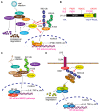Pleiotropic Roles of a KEAP1-Associated Deubiquitinase, OTUD1
- PMID: 36829909
- PMCID: PMC9952104
- DOI: 10.3390/antiox12020350
Pleiotropic Roles of a KEAP1-Associated Deubiquitinase, OTUD1
Abstract
Protein ubiquitination, which is catalyzed by ubiquitin-activating enzymes, ubiquitin-conjugating enzymes, and ubiquitin ligases, is a crucial post-translational modification to regulate numerous cellular functions in a spatio-temporal-specific manner. The human genome encodes ~100 deubiquitinating enzymes (DUBs), which antagonistically regulate the ubiquitin system. OTUD1, an ovarian tumor protease (OTU) family DUB, has an N-terminal-disordered alanine-, proline-, glycine-rich region (APGR), a catalytic OTU domain, and a ubiquitin-interacting motif (UIM). OTUD1 preferentially hydrolyzes lysine-63-linked ubiquitin chains in vitro; however, recent studies indicate that OTUD1 cleaves various ubiquitin linkages, and is involved in the regulation of multiple cellular functions. Thus, OTUD1 predominantly functions as a tumor suppressor by targeting p53, SMAD7, PTEN, AKT, IREB2, YAP, MCL1, and AIF. Furthermore, OTUD1 regulates antiviral signaling, innate and acquired immune responses, and cell death pathways. Similar to Nrf2, OTUD1 contains a KEAP1-binding ETGE motif in its APGR and regulates the reactive oxygen species (ROS)-mediated oxidative stress response and cell death. Importantly, in addition to its association with various cancers, including multiple myeloma, OTUD1 is involved in acute graft-versus-host disease and autoimmune diseases such as systemic lupus erythematosus, rheumatoid arthritis, and ulcerative colitis. Thus, OTUD1 is an important DUB as a therapeutic target for a variety of diseases.
Keywords: KEAP1; OTUD1; antiviral response; cancer; cell death; deubiquitinating enzyme; ubiquitin.
Conflict of interest statement
The authors declare no conflict of interest.
Figures






Similar articles
-
OTUD1 deubiquitinase regulates NF-κB- and KEAP1-mediated inflammatory responses and reactive oxygen species-associated cell death pathways.Cell Death Dis. 2022 Aug 8;13(8):694. doi: 10.1038/s41419-022-05145-5. Cell Death Dis. 2022. PMID: 35941131 Free PMC article.
-
Development of an OTUD1 ubiquitin variant inhibitor.Biochem J. 2023 Aug 30;480(16):1317-1330. doi: 10.1042/BCJ20230119. Biochem J. 2023. PMID: 37589489
-
Ovarian tumor domain-containing protein 1 deubiquitinates and stabilizes p53.Cell Signal. 2017 May;33:22-29. doi: 10.1016/j.cellsig.2017.02.011. Epub 2017 Feb 13. Cell Signal. 2017. PMID: 28216291
-
The exploitation of host autophagy and ubiquitin machinery by Mycobacterium tuberculosis in shaping immune responses and host defense during infection.Autophagy. 2023 Jan;19(1):3-23. doi: 10.1080/15548627.2021.2021495. Epub 2022 Jan 9. Autophagy. 2023. PMID: 35000542 Free PMC article. Review.
-
Regulation of proteolysis by human deubiquitinating enzymes.Biochim Biophys Acta. 2014 Jan;1843(1):114-28. doi: 10.1016/j.bbamcr.2013.06.027. Epub 2013 Jul 9. Biochim Biophys Acta. 2014. PMID: 23845989 Free PMC article. Review.
Cited by
-
A review of deubiquitinases and thier roles in tumorigenesis and development.Front Bioeng Biotechnol. 2023 May 12;11:1204472. doi: 10.3389/fbioe.2023.1204472. eCollection 2023. Front Bioeng Biotechnol. 2023. PMID: 37251574 Free PMC article. Review.
-
Deubiquitinase OTUD7B stabilizes HNF4α to alleviate pressure overload-induced cardiac hypertrophy by regulating fatty acid oxidation and inhibiting ferroptosis.Biomark Res. 2025 Mar 29;13(1):53. doi: 10.1186/s40364-025-00766-2. Biomark Res. 2025. PMID: 40158182 Free PMC article.
-
OTUD1 deficiency attenuates myocardial ischemia/reperfusion induced cardiomyocyte apoptosis by regulating RACK1 phosphorylation.Acta Pharmacol Sin. 2025 May 20. doi: 10.1038/s41401-025-01567-x. Online ahead of print. Acta Pharmacol Sin. 2025. PMID: 40394237
-
METTL3‑mediated m6A methylation and its impact on OTUD1 expression in chronic obstructive pulmonary disease.Mol Med Rep. 2025 Aug;32(2):206. doi: 10.3892/mmr.2025.13571. Epub 2025 May 26. Mol Med Rep. 2025. PMID: 40417884 Free PMC article.
-
OTUD1 inhibits osteoclast differentiation and osteoclastic bone loss through deubiquitinating and stabilizing PRDX1.Theranostics. 2025 Jun 9;15(14):6719-6736. doi: 10.7150/thno.111360. eCollection 2025. Theranostics. 2025. PMID: 40585986 Free PMC article.
References
Publication types
Grants and funding
LinkOut - more resources
Full Text Sources
Research Materials
Miscellaneous

